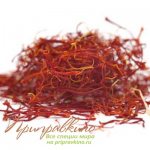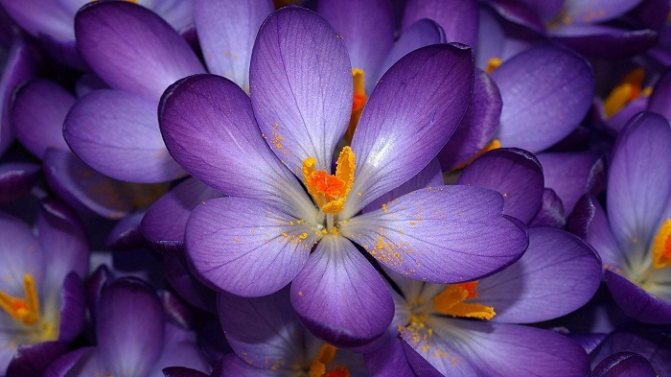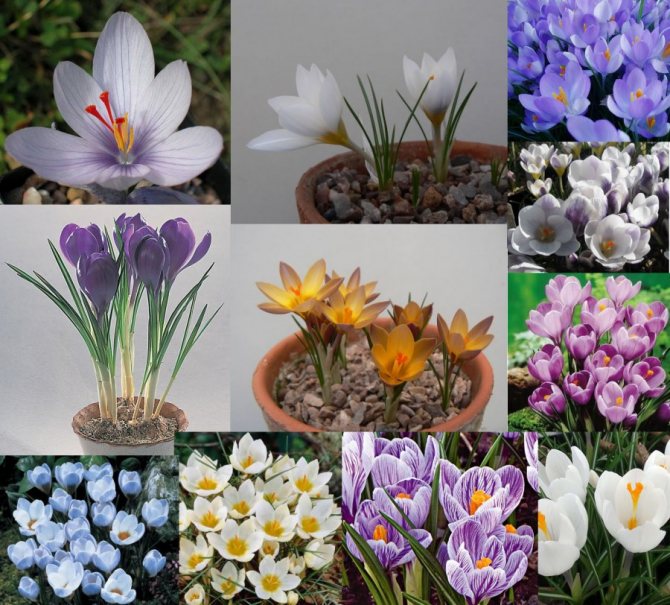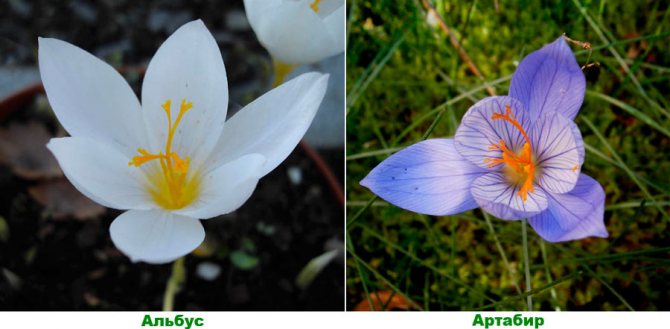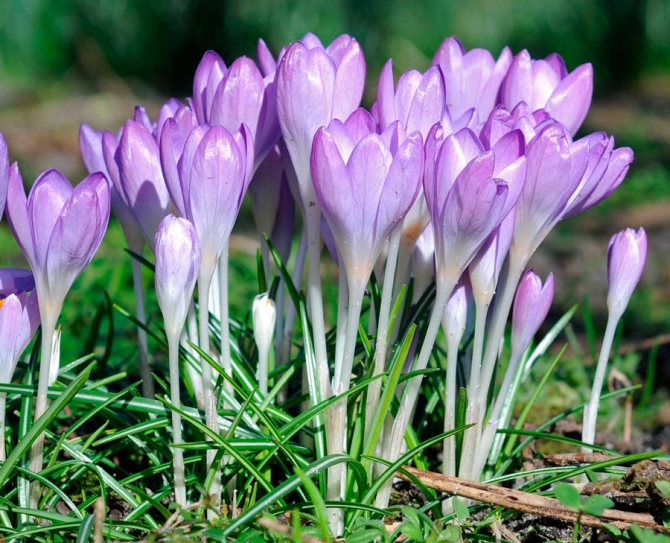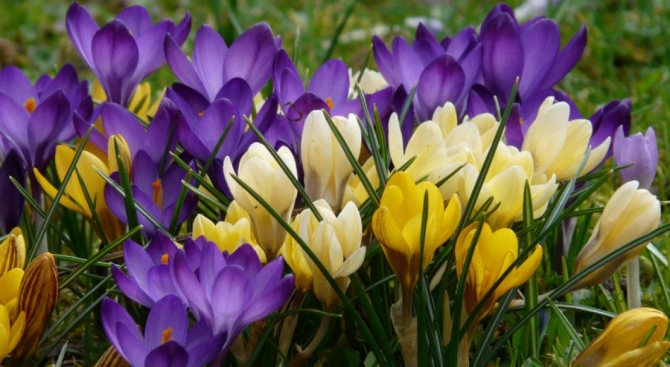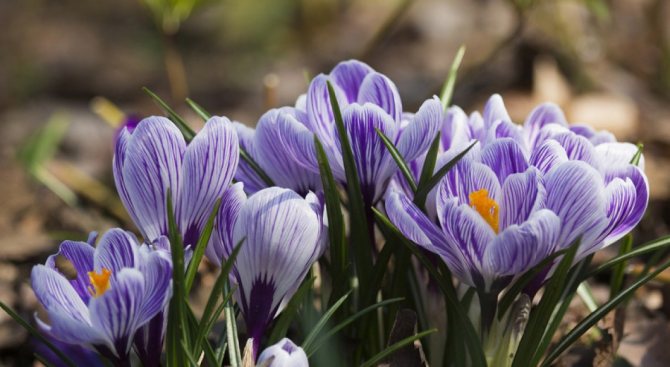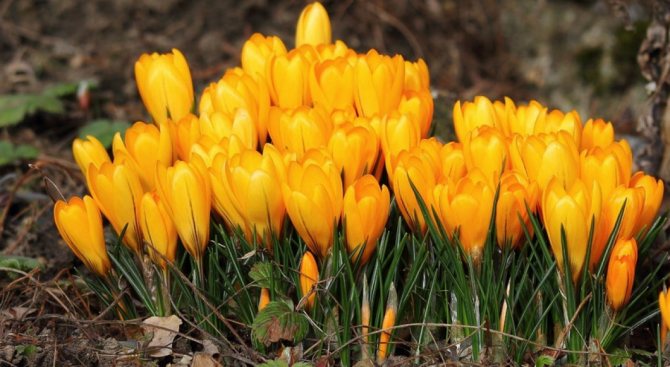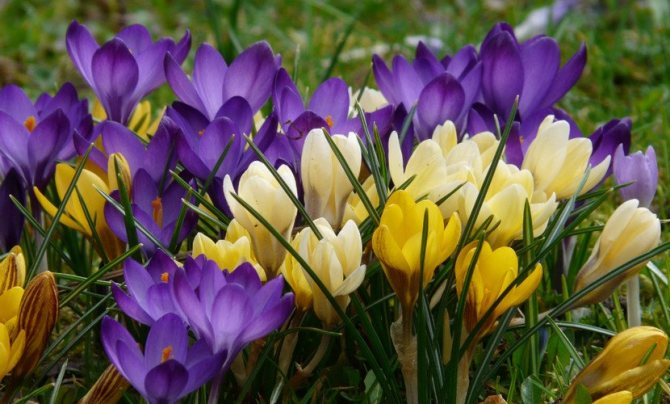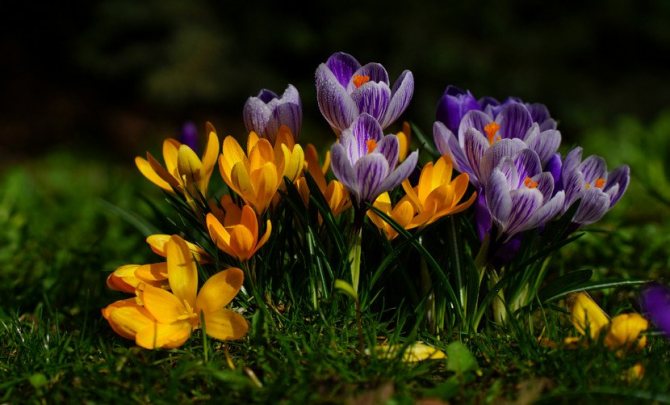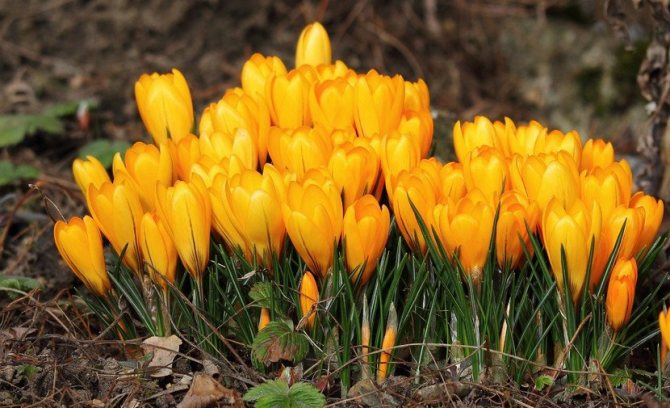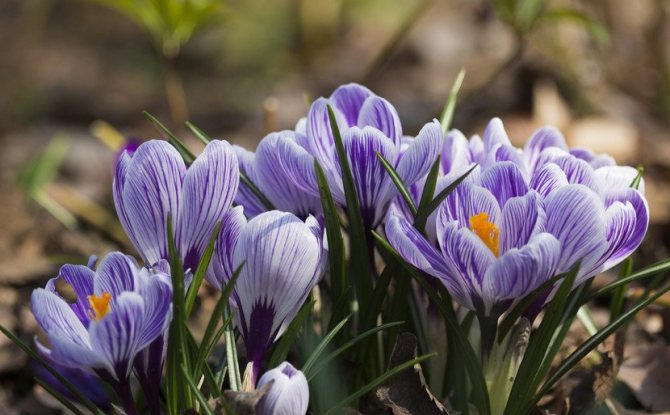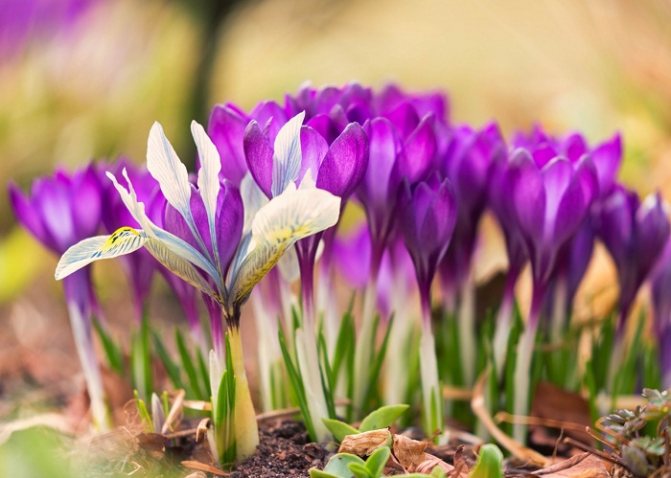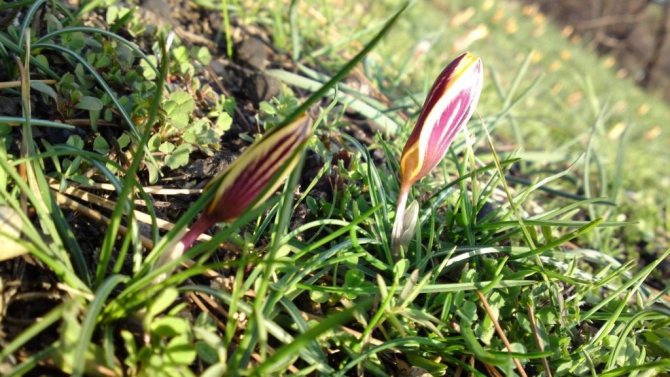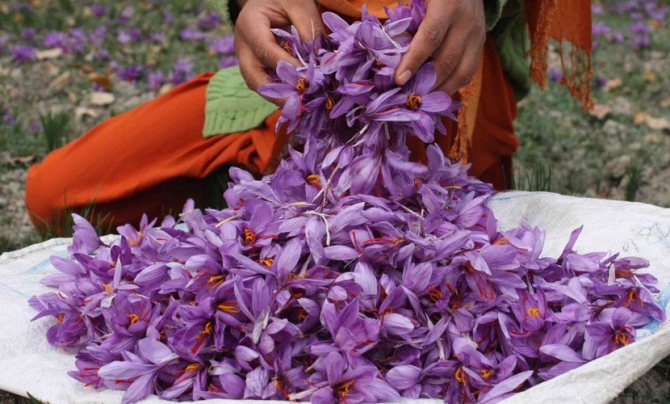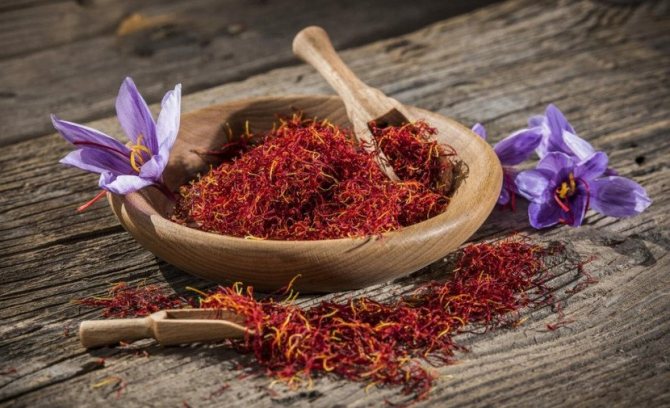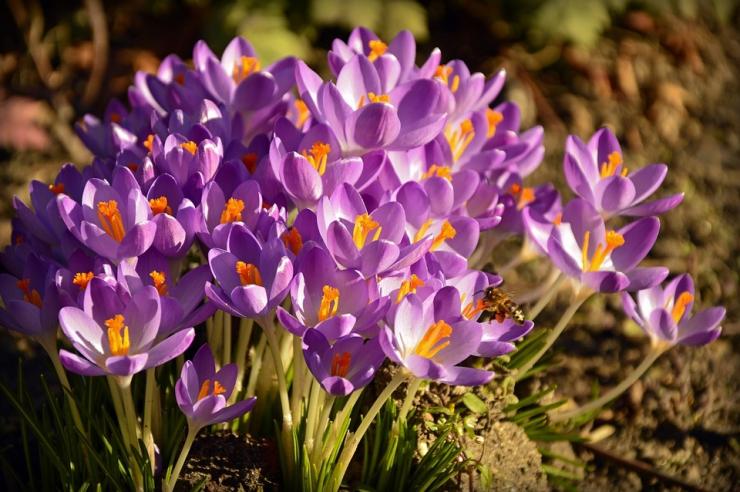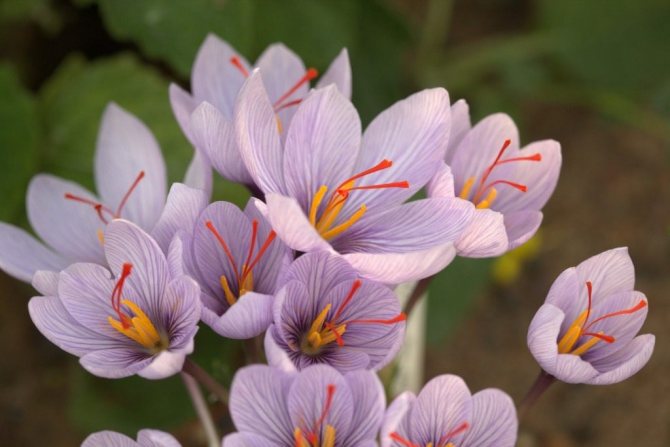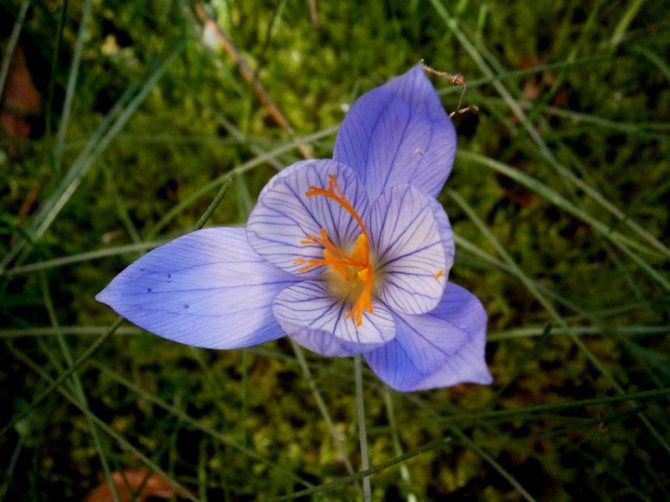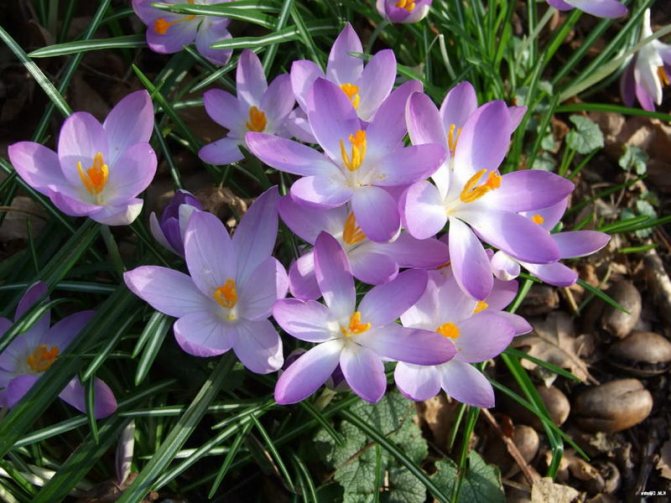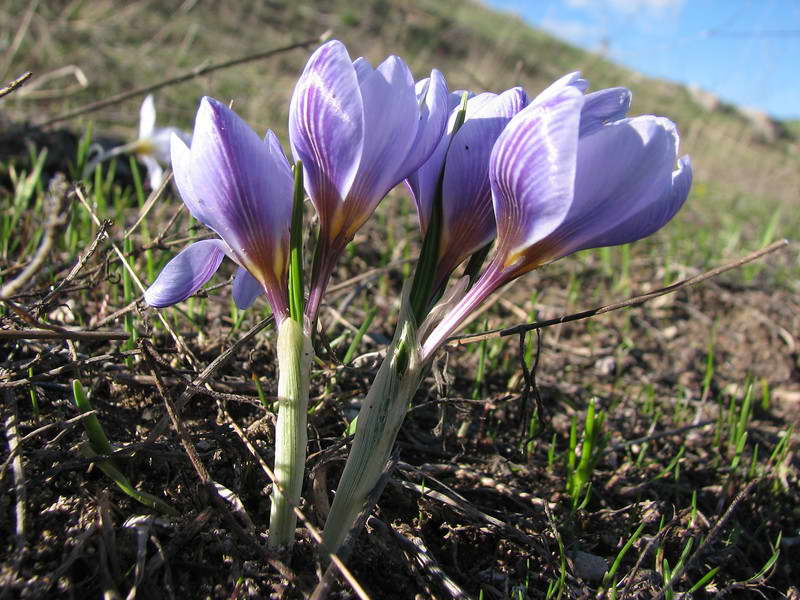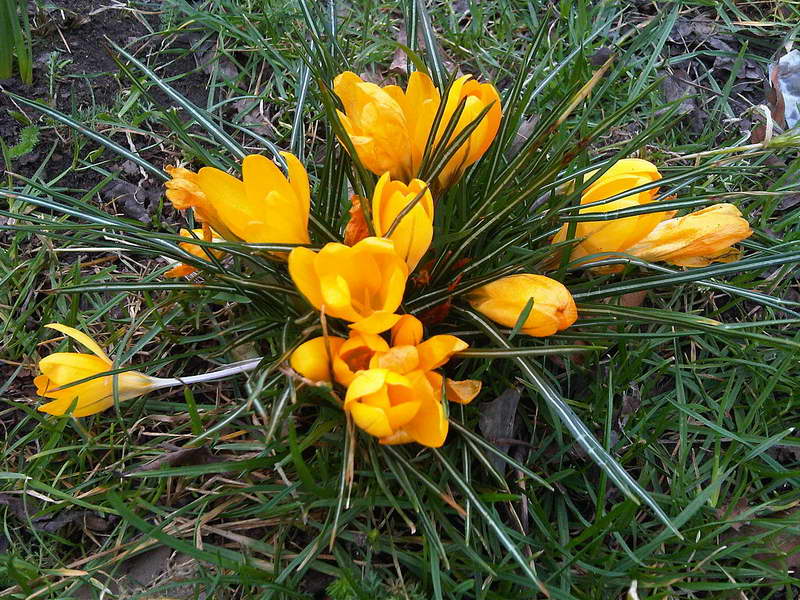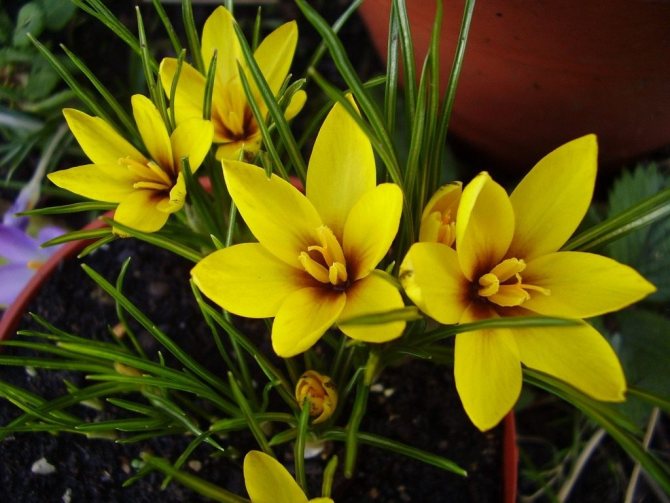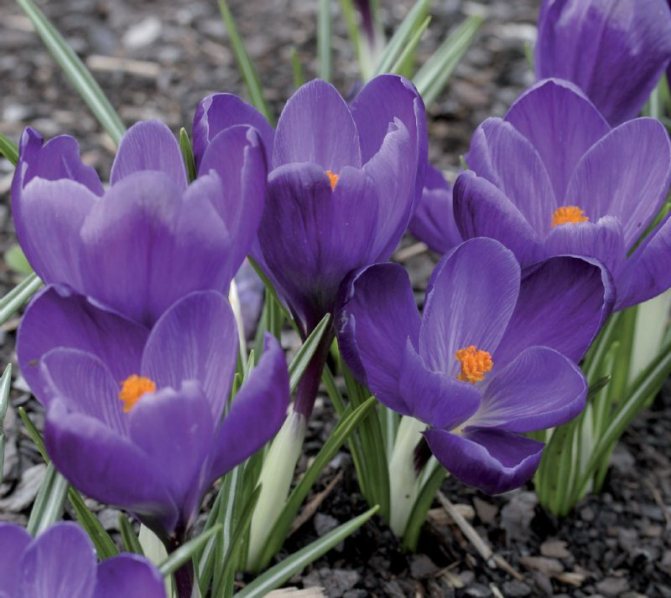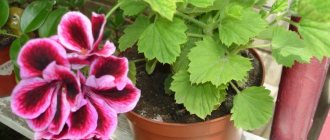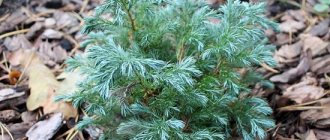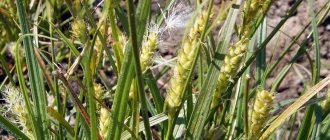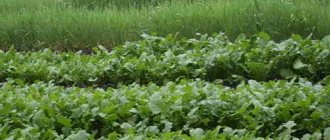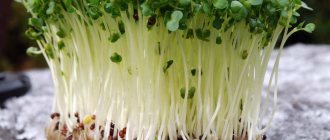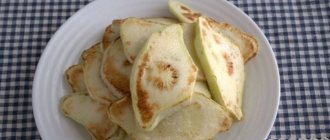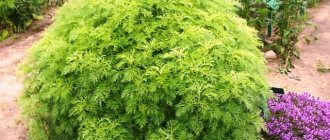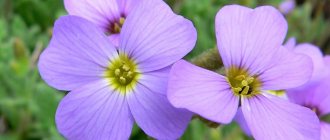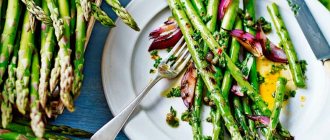Crocus (Crocus), or saffron, is a genus of bulbous herbaceous plants that belongs to the Iris family. In the wild, this plant is found in Southern, Central and Northern Europe, in the Middle East, in the Mediterranean, in Central and Asia Minor. Crocuses prefer to grow in forests, steppes and meadows. There is a description of 80 species of this plant, as well as 300 varieties. The name "crocus" comes from the Greek word that translates as "fiber, thread". The name "saffron" comes from the Arabic word, translated as "yellow", this is because the stigma of the flowers is precisely this color. A mention of this plant was found in Egyptian papyri, both doctors and philosophers wrote about the crocus. Today, such a plant is also very popular with gardeners, because it is one of the most beautiful primroses (early spring flowers). But few people know that there are a large number of species of such plants, the flowering of which occurs in autumn.
What it is
Saffron is a dried orange-red "stigma" or strings of a particular crocus flower that is used as a fragrant bitter seasoning and coloring base for both food and drink.
Each flower has only 3 strands, they are carefully hand-picked as soon as the crocus opens. Almost 75,000 crocus flowers have to be harvested and processed to produce just half a kilogram of dried saffron, so this spice comes at a fairly high price.
Just a few strands of saffron infuse food with an intense yellow color and unmatched aroma.
The world's most popular saffron dishes are French broth, Italian Milanese risotto, Spanish paella and Indian biriani and pulao.
It is used not only in food and beverage preparation, but also in medicines, perfumes and paints.
What saffron looks like - photo
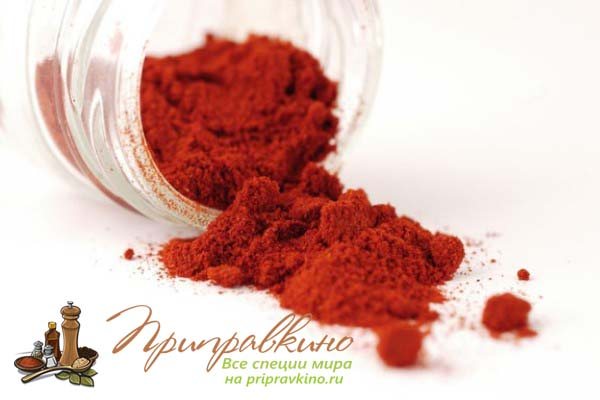
general description
This exotic spice is native to southern Europe and is today cultivated in many countries around the world, especially in Spain, Italy, France, Greece, Turkey, Iran and the Indian states of Jammu and Kashmir. It is no longer found in the wild.
Iran is the largest supplier of saffron (about 90% of world production).
Crocus seed is a bulbous perennial plant belonging to the Iris family, known by the botanical name Crocus sativus.
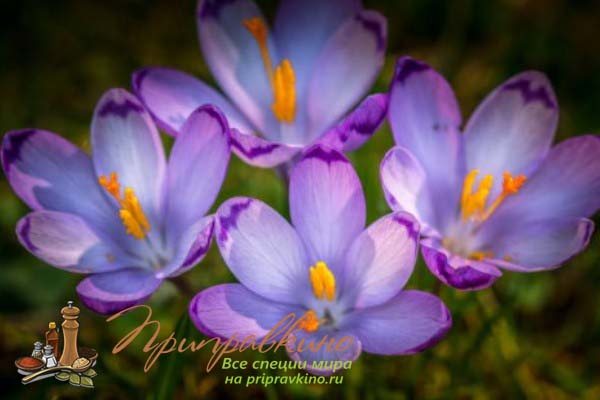

It grows to about 15-20 cm in height and blooms for only a couple of weeks between October and November. Each bulb produces 2-3 flowers.
Lavender flowers have a perianth, consisting of a pistil connecting three "stigmas" or threads to the rest of the plant. Each stigma is 3 from 3 to 5 cm long and looks like tubes 0.5-1 mm wide expanding towards the apex. These orange-yellow colored threads, along with the pistil, represent saffron, a valuable condiment. The exquisite petals and stamens are of no value.
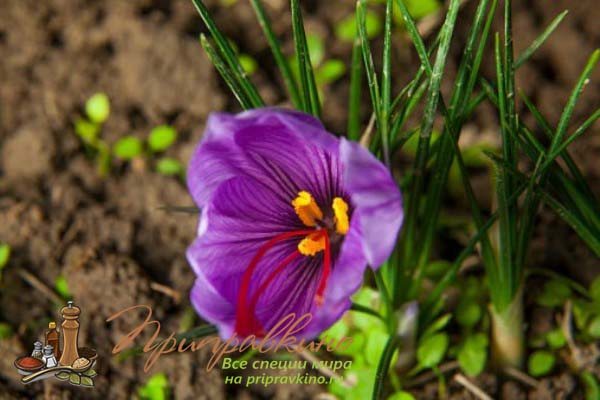

To obtain 1 kg of spice, hundreds of thousands of crocus flowers will be needed.
Several inexpensive orange-red spices are mistakenly called saffron:
- turmeric ("Indian saffron");
- marigolds ("Imeretian saffron");
- safflower ("Mexican saffron").
In fact, there is only one saffron - Iranian (aka Spanish). It has no other names, this is real saffron - the most expensive spice in the world.
Planting saffron
Most often, bulbs are used for planting and breeding crocuses. Before planting, they are thoroughly visually inspected for the presence of arrows - small shoots that should be left in place without breaking. If there are traces of damage or microtrauma on the planting material, they must be disinfected by dusting with wood ash.
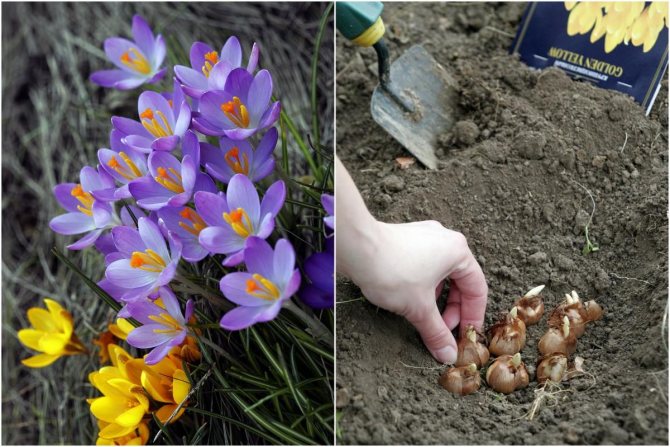

Planting saffron
On heavier soils, the planting depth of the bulbs should not exceed 8 cm, while on soils with a light composition, this indicator can be increased to 12 cm.Spatial isolation between the bulbs should remain at the level of 7-10 cm.Its absence will cause the risk of spreading fungal diseases and reduces the duration of the flowering period. Upon completion of planting, the plots are abundantly shed and mulched. It is recommended to use ground plant residues or humus as a mulching material.
Another method is sowing seeds, which is usually used in cases where it is necessary to quickly obtain a large number of varietal plants. Seeds are sown into the ground to a depth of no more than 1 cm. Plants obtained on a seed basis begin to bloom, as a rule, in the 3-4th year.
How the seasoning is made
Obtaining saffron is very laborious, so you need to collect delicate crocus flowers by hand during mass flowering. The flowers are carefully picked and transferred to rooms and under sheds in order to separate the pistils on the same day.
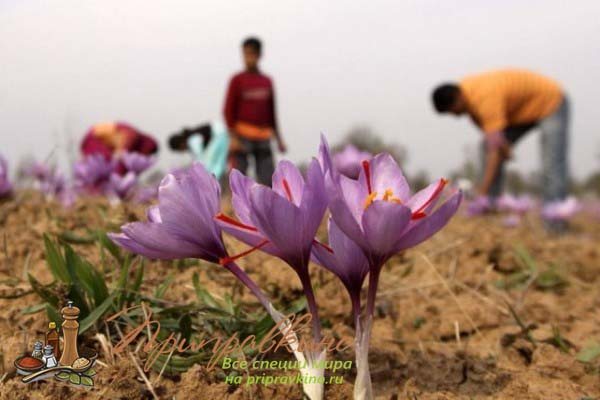

The yellow columns are separated from the stigmas immediately after harvest, or the finished saffron is sorted out, choosing the yellow parts.
The yarns are then dried in the sun or in a drying plant. Thousands of flowers must be harvested and processed for one gram of saffron.
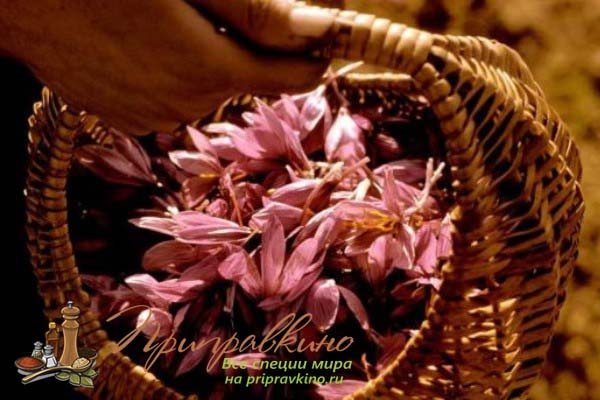

Crocus features
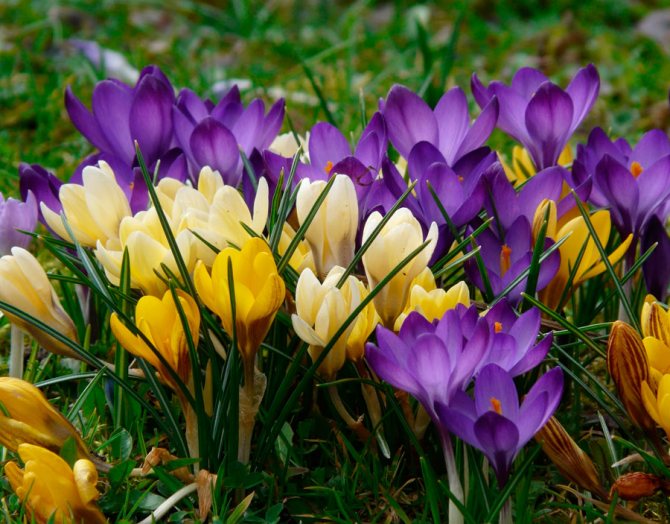

Crocus is a low-growing plant, which usually does not exceed 10 centimeters in height. The bulbs reach 30 mm in diameter, they have a round or flattened shape. The surface of the bulbs is covered with scales, and they also have a bunch of fibrous roots. Shoots of such a plant do not grow. During flowering or after it, narrow basal leaf plates of a linear shape grow, they are collected in a bundle and covered with scales. Single goblet flowers reach 20-50 mm in diameter. Flowers can be cream, purple, yellow, white, blue, purple or orange. They bloom on a leafless short peduncle and are surrounded by membranous scales. There are varieties with a two-color or spotted flower color. Mass flowering lasts 15 to 20 days. All types and varieties of this plant are divided into 15 groups.
How to choose and where to buy
There are 2 forms of this seasoning commercially available: individual stigmas and powder. Fresh saffron is sold in specialty spice stores. Shredded can be found in large grocery supermarkets. Try buying whole dry thread (stigmas) instead of powdered form, as it is often falsified. Choose a well-sealed container with an authentic brand name, with date of packaging and expiration date.
The fresh spice has a bright red color, and when rubbed between the fingers, a very pleasant aroma should stand out and a spot of golden yellow color should form on the skin. Look for long strands, 2 to 4 cm. Avoid low quality product with gray-colored streaks or light spots.
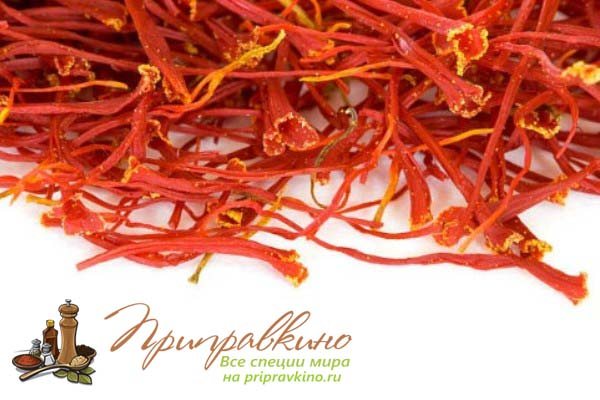

Avoid buying ground saffron (in powder form) as it is common to counterfeit this expensive condiment.
Saffron is counterfeited with turmeric, calendula flowers, safflower, scraps of cotton threads. To make it heavier, soak in water or vegetable oil.To improve the appearance, the counterfeit is tinted with synthetic dyes.
Starch, soda, salt, gypsum, ground red pepper, etc. are mixed with low-quality ground saffron.
The high quality of this spice is guaranteed by the ISO certificate obtained by the manufacturer, which takes into account all the criteria for real saffron. Saffron is divided into 4 categories:
| Category | Characteristic | ISO unit, min |
| 1 | Only dyed threads 2.5-4 cm long | 190 |
| 2 | Stigma with a part of the pistil, the length of the unpainted part 0.3-1 cm | 150 |
| 3 | Entire pistil, unpainted part equal to the length of the threads | 110 |
| 4 | Ground and cut saffron | 80 |
This spice is very expensive, but just a pinch of good saffron enlivens the whole dish, so the purchase will not ruin the family budget. Cheap saffron is a dubious purchase: it is either very old or mixed with saffron pistils (another part of the crocus) or with calendula flowers and other impurities.
Estimated price: from $ 12 per gram.
You can buy saffron threads of proven brands in the well-known global online store IHerb.
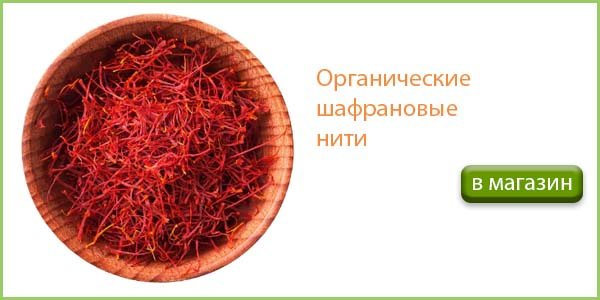

Diseases and pests
On the territory of Russia, crocuses are threatened by mice and moles, they damage the bulbs when they dig their own tunnels. The mice cut the tubers and carry them to the burrow. The gnawed tubers begin to rot, the plant grows poorly, and there is no flowering. In addition to rodents, crocuses are attacked by caterpillars, they gnaw leaves and stems. In clay soils, mucus settles, which eats the tuber.
Saffron can become infected with viral, fungal infections:
- Aphids are a frequent visitor to crocuses, sucking the juice out of the flower. The leaves turn yellow, curl and fall off. The plant is covered with sugar grains. When a parasite is found, saffron is treated with drugs: Decis, Karate, Aktellik, Inta-vir, Neoron, Arrivo, Aktara.
- The spider mite also loves to feast on the delicious juice from the plant. The leaves turn yellow and fall off, the flower is wrapped in a thin cobweb. Crocus is treated with acaricides.
- In highly moistened soil, the primrose is attacked by gray rot. Brown spots appear on the leaf blade, which increase over time, the leaves curl and fall off.
How and how much to store
The sun's rays oxidize the pigments in saffron and spoil its flavor. Store this spice in a tightly closed glass container in a cool, dark place (preferably inside the refrigerator). Saffron has a shelf life of six months. It can take longer, it will not deteriorate, but it will gradually lose its taste.
The original storage method is to make saffron water:
- Soak 1 teaspoon of dried and shredded saffron strands in 2 cups of hot water.
- When the water has cooled, pour it into ice trays and freeze.
- Transfer the frozen cubes to a bag and return to the freezer.
One saffron ice cube is used instead of a pinch of saffron threads.
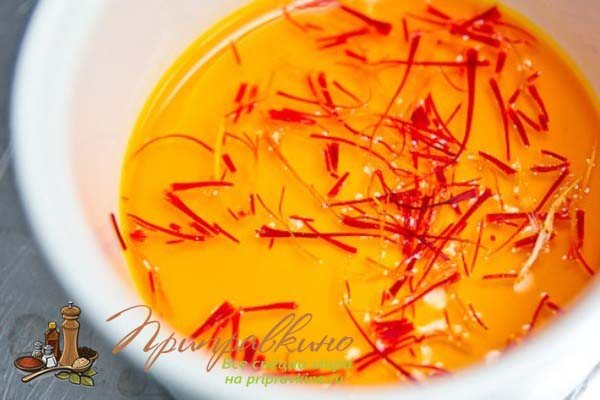

Reproduction of culture
A simpler breeding method is bulb division. In this case, as the mother bulb dies off, the new bulbs need to increase the living space. After 2-3 years, a compacted bulbous nest forms in this place, which should be planted.
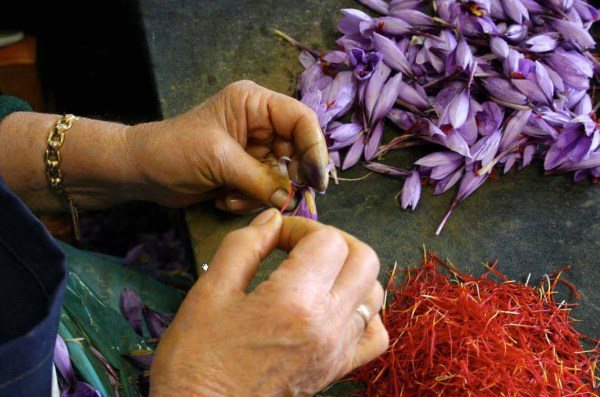

Growing saffron
Seed propagation is also practiced. At the end of the collection from the ripe bolls, the seed is subjected to two to three weeks of drying. If necessary, seeds are calibrated and treated to disinfect and protect against disease.
Chemical composition
Saffron contains chemical compounds that prevent disease and promote health.
Nutritional value of saffron (Crocus sativus) per 100 g.
| Name | number | Percentage of the daily value,% |
| Energy value (calorie content) | 310 Kcal | 15,5 |
| Carbohydrates | 65.37 g | 50 |
| Protein | 11.43 g | 21 |
| Fats | 5.85 g | 21 |
| Dietary fiber | 3.9 g | 10 |
| Folates | 93 μg | 23 |
| Niacin | 1.46 mg | 9 |
| Pyridoxine | 1,010 mg | 77 |
| Riboflavin | 0.267 mg | 20 |
| Vitamin A | 530 IU | 18 |
| Vitamin C | 80.8 mg | 135 |
| Sodium | 148 mg | 10 |
| Potassium | 1724 mg | 37 |
| Calcium | 111 mg | 11 |
| Copper | 0.328 mg | 37 |
| Iron | 11.10 mg | 139 |
| Magnesium | 264 mg | 66 |
| Manganese | 28.408 mg | 1235 |
| Phosphorus | 252 mg | 36 |
| Selenium | 5.6 mcg | 10 |
| Zinc | 1.09 mg | 10 |
What is the difference?
Comparative characteristics of plants.
| Indicator | Marigold | Saffron |
| Family | Astrovye | Iris |
| Stem | Branched, straight | Absent |
| Root | Branched, there are adventitious processes | In the form of an onion |
| Homeland | America | India, Middle East |
| Effects on the body (is both a difference and a similarity). | Benefits for individual organs and systems. | Rejuvenating and general healing effect. |
| Cooking use | Included in herbal preparations. | The most expensive spice. Poorly combined with other spices. |
Beneficial features
Modern scientific research shows that saffron does have valuable health benefits and plays a role in the fight against disease.
The flower pistils of saffron contain several essential oils, the most important of which is safranal, which gives the spice its pleasant aroma. Other volatile oils in the composition are cineole, phenethenol, pinene, borneol, geraniol, limonene, p-cymene, linalool, terpinene-4-oil, etc.
This colorful spice contains many non-volatile active ingredients: α-crocin, a carotenoid compound that gives pistils their natural golden yellow color. There are other carotenoids in saffron, including zeaxanthin, lycopene, α- and β-carotenes. These are important antioxidants that help protect the human body from cancer, infections, and act as immunomodulators.
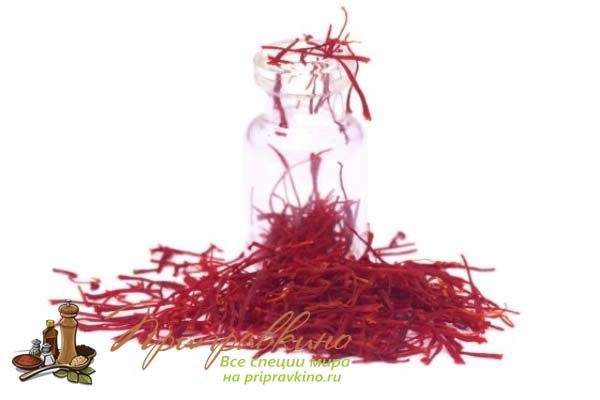

This spice is an excellent source of minerals such as copper, potassium, calcium, manganese, iron, selenium, zinc and magnesium. Potassium is an important component of cells and body fluids that help control heart rate and blood pressure. The human body uses manganese and copper as co-factors for the antioxidant enzyme, superoxide dismutase. Iron is essential for the production of red blood cells and as a cofactor for cytochrome oxidase enzymes.
Saffron is also rich in many vital nutrients, including vitamins A and C, folic acid, riboflavin, and niacin, which are essential to support optimal health.
The active ingredients in saffron help in the treatment and relief of symptoms of problems such as:
- heart diseases;
- colds and coughs;
- diseases of the gastrointestinal tract;
- insulin resistance;
- depression;
- premenstrual syndrome;
- insomnia and anxiety;
- retinal degeneration that occurs with age.
Plant care
Like most plants of the Iris family, saffron is considered one of the most unpretentious garden and ornamental crops, but even it needs a certain minimum of agrotechnical measures. In ultra-early varieties, it is only required to pre-cut the grass cover before the start of wintering. This is due to the fact that their flowering phase coincides with the beginning of the melting period of snow masses, when no work has yet begun on the site.
Irrigation
When watering saffron, the main thing is the moderation of the amount of introduced moisture. Flowering takes place in relatively cool periods of the year, as a result of which the liquid from the ground does not have time to evaporate in time, causing stagnation in the soil. This, in turn, leads to rotting of the tuberous bulbs. If the plants are planted in sand, then a single irrigation per month is sufficient.
Top dressing
The optimal options for organic fertilizers for crocuses are completely rotted manure and peat. During the period of active plant growth, a ready-made complex of mineral fertilizers shows high efficiency. On saffrons, which bloom in spring and are primroses, they practice scattering fertilizers over the surface of melting snow in early spring.As the first shoots form, additional feeding is carried out using urea.
After two weeks, phosphorus-potassium fertilizers are applied under the crocuses. This is necessary in order to strengthen the plantings and improve their health. If it is impossible to use them, it is allowed to use wood ash as an alternative.
Important! In no case should fresh manure be used, as it is a suitable medium for the spread of a number of diseases.
Cooking applications
One pinch of fresh saffron is enough to enhance the flavor and color of the entire dish.
It is a fairly versatile spice that can be used in both savory and sweet recipes.
Saffron does not mix well with other spices and therefore is not included in spice mixtures, but is almost always consumed on its own.
There are several ways to use it in the kitchen:
- Whole threads can be added directly to dishes.
- The threads are crushed with a pestle and mortar.
- Before adding to dry dishes, saffron threads are pre-poured with hot water to reveal the aroma.
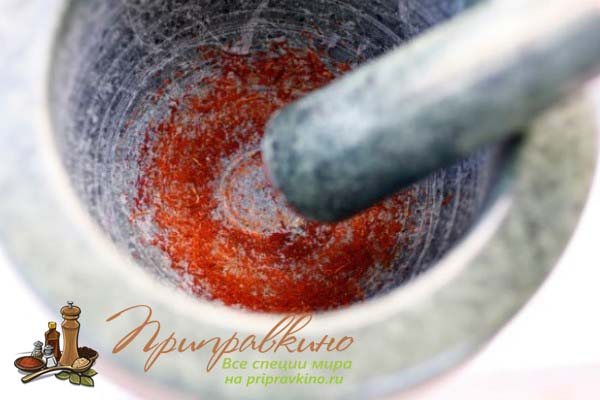

Here are some tips on where to put saffron:
- Paella, risotto and other rice dishes.
- In soups and sauces.
- Desserts include custards and ice cream.
- It is a great addition to chicken.
- For a delicious marinade for fish, mix chopped saffron threads, garlic, thyme and vinegar.
- It is added to dough to give sweet baked goods (cakes, pastries and biscuits) a golden hue and delicate aroma.
- A tiny pinch of saffron added to a glass of champagne will transform the drink into a golden elixir.
- Tea or coffee flavored with saffron and cardamom are calming and healing drinks that are good for the heart.
- Saffron and cinnamon are added to whole milk or yogurt and honey for a simple version of the famous Indian yoghurt lassi drink.
- It is an excellent substitute for synthetic yellow food colors.
Pulao (rice with saffron) - recipe
Ingredients for 4-5 servings:
- 1.5 tablespoons of ghee oil.
- 5 whole green cardamom pods, crush lightly.
- 5 pieces. carnations.
- 1 cinnamon stick
- 2 whole bay leaves.
- 1 PC. star anise (star anise).
- 2 cups basmati rice (do not soak)
- 0.5-1 teaspoon of salt, to taste.
- 3 cups of boiling water.
- A generous pinch of saffron threads soaked in warm water.
- A small handful of cashews and raisins, for garnish.
Cooking method:
- Heat the ghee in a heavy-bottomed saucepan over medium-high heat.
- Add the cardamom, cloves, cinnamon, bay leaf, and star anise and heat, stirring occasionally, for one minute, until the spices begin to smell.
- Add rice and salt and cook gently for another 2 minutes, until the rice is soaked in spices.
- Cover with boiling water and add saffron. Bring to a boil, then lower the heating temperature.
- Cover the pan tightly with aluminum foil, squeezing the edges so that it fits snugly, and place a lid on top. Use an oven mitt to avoid scalding.
- After 15 minutes, remove the pan from the stove and let sit for another 5 minutes.
- Uncover the rice and spread with a fork. Toss with cashews and raisins (optional) and serve.
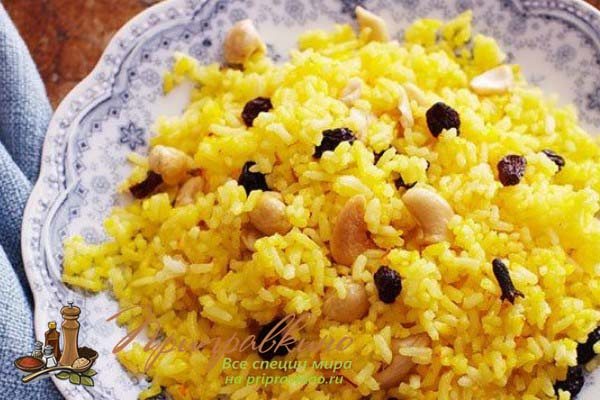

Tip: You can make other dishes based on this Pulao recipe. For example, add vegetables immediately after heating the spices and cook for a couple of minutes before adding the rice. Add a teaspoon of garam masala to your vegetables for an even more mouth-watering flavor.
Saffron risotto recipe - video
Harvesting and storage of crops
Corms begin to be harvested immediately after the foliage begins to turn yellow. In the middle lane and northern regions, the procedure is carried out in the first half of summer, and in the south of Russia - in May-June. Harvesting is recommended annually, although the plant can usually be cultivated in one place for up to 4-5 years.
The remnants of the uterine tuberous bulb should be easily and without difficulty separating from the new bulb.The collected plant materials are laid out under a canopy for drying and cleaned of earth clods, particles of mother bulbs, scales. Then the bulbs are divided into varieties and placed in wooden boxes, which are installed in a dry and ventilated room. During storage, the optimum temperature for crocuses should be maintained - +18, 20C.
How to replace saffron in a recipe
Saffron has a unique aroma and flavor that is so difficult to replicate that some even argue that there is no substitute for this spice.
If you find it difficult to find a justification for buying such an expensive condiment, you still have several options for replacing saffron:
- A small amount of turmeric mimics saffron in color, but does not substitute for taste. Experts suggest combining it with paprika. To make this substitute, combine ¼ teaspoon of turmeric with ½ teaspoon of saffron.
- Safflower is considered an excellent substitute for saffron, as it has the same ability to color food and a pleasant, original taste. If a recipe requires 1 teaspoon of saffron, use a teaspoon of safflower instead.
- You can use marigold flowers to recreate the same color as saffron. You will need to dry the flowers and then grind to a powder that can be added to the dish instead of the saffron threads.
You have read the complete information on what saffron is and how to choose and use it correctly. The beneficial properties of this spice make it a valuable culinary ingredient, popular all over the world. Try saffron and you may become your new culinary favorite.
Planting crocuses in open ground
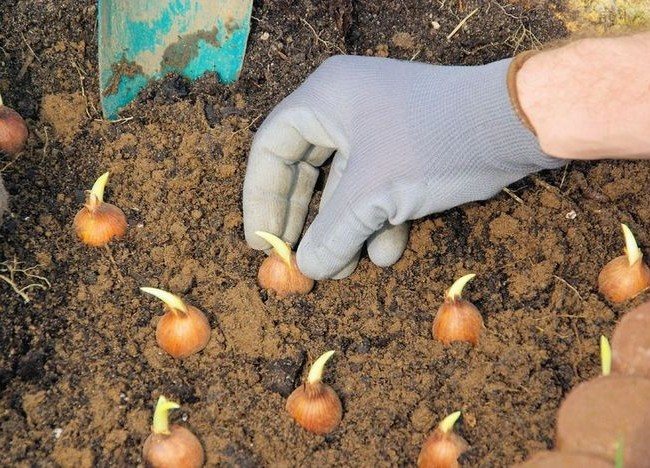

What time to plant
Spring-flowering crocus species should be planted in open soil in the fall. Those species that bloom in autumn are planted in summer. You need to choose a well-lit site for planting, but such flowers grow quite well in a shaded place or in the shade. The soil suitable for crocuses should be dry, light, loose and rich in nutrients. When preparing the site for planting, it is recommended to add coarse river sand or fine gravel to the soil for drainage. As organic matter, rotted manure, compost or lime with peat should be added to the soil for digging, the fact is that this primrose grows poorly on acidic soil. If the soil is clayey, this is corrected by introducing wood ash into it. There are species that cannot be grown on wet soil, therefore, experts advise for them to make high beds, where the drainage layer is made of gravel or crushed stone. Inspection of the planting material is carried out; it should not be injured or have flaws.
Autumn planting
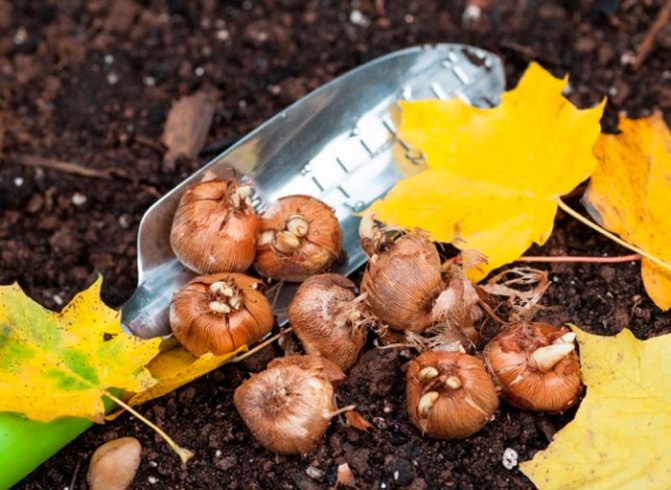

If the bulbs are planted in open soil in September, then flowering can be seen already in spring. The bulbs are planted in loose soil, while they should be planted to a depth that is a couple of times their size. If the planting is carried out in heavy soil, then it will be necessary to deepen the bulb by only one of its value. On average, a distance of 7-10 centimeters should be kept between the bulbs. The planted flowers need abundant watering. Crocuses should not be planted too close, since it is recommended to grow them in the same place for 3-5 years, over the years, a colony of children appears in the bulbs, and the site itself becomes a solid carpet of flowers. After 5 years, these flowers are planted.
Planting for distillation
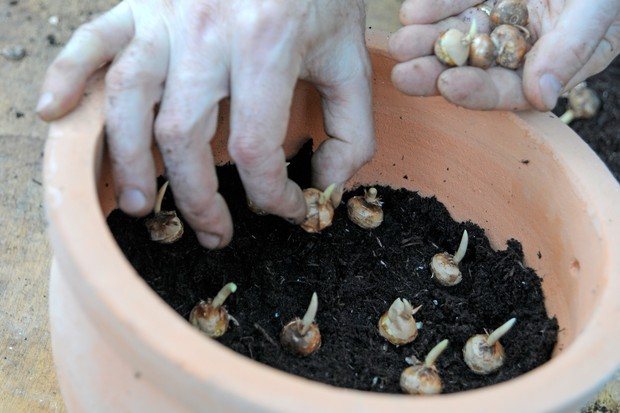

Most flower growers like to grow garden flowers indoors in winter. The easiest way to grow bulbs in this way, which includes crocuses. Experienced growers advise choosing Dutch large-flowered varieties for forcing. 5-10 bulbs are selected, which should have approximately the same size.They are planted in 1 pot, which should not be very deep, but wide enough, as a result of such a planting you will grow a whole bunch of beautiful flowers. To fill flower pots, use a loose, neutral soil that allows water and air to pass through well.
Faded bulbs do not need to be thrown away. They are provided with regular watering and feeding with a weak solution of complex mineral fertilizers for indoor plants. After the foliage begins to change its color to yellow, watering is gradually reduced until it stops completely. When the foliage is completely dry, the bulbs should be removed from the container. When the remaining substrate is removed from them, they should be wrapped in napkins and folded into a cardboard box. The planting material is harvested in a dark, dry place where it will be stored until planting in open soil in the fall.
How to grow crocuses from seeds
The seed method is used for rare varieties and for those crocuses that are reluctant to reproduce vegetatively. They begin sowing in mid-March or early April.
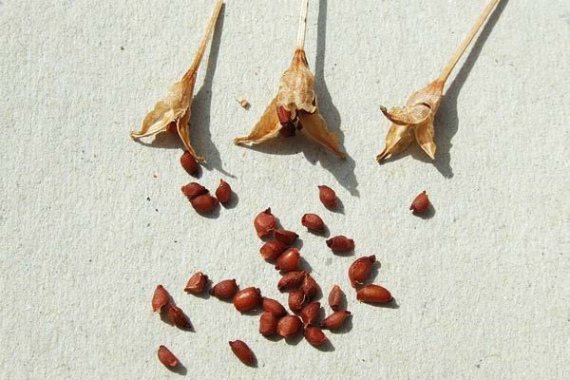

- Before planting, seed material needs to be disinfected, treated with growth stimulants, and stratification.
- Seeds are sown in wet sand, without deepening, covered with foil and put into the refrigerator for 15-20 days.
- After that, the container is dropped in the garden, at first covered with agrofibre.
- As soon as shoots appear, the soil must be moistened with a spray bottle.
Crocuses, which bloom in spring, are sown in the ground in mid-September, also pretreating the seeds, but without stratification. The soil should be porous and loose; this is achieved by the introduction of peat and sand.
When to dig up the crocus bulbs?
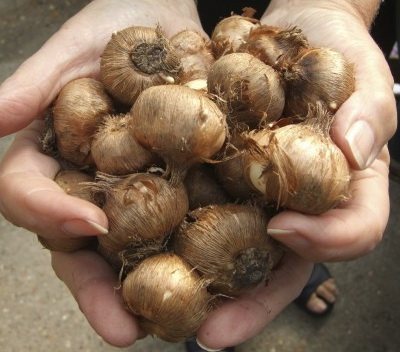

How to keep crocuses in winter
The need to dig up the bulbs arises after 3-4 years. During this time, the mother bulb will become overgrown with many daughter bulbs that will interfere with each other, the flowers will become small. You can dig, transplant, divide the bulbs more often.
You can dig up spring-flowering crocuses from July to September, autumn-flowering ones - from June to August.
Dig up the bulbs, peel off the soil, remove the dead scales, lay them in a single layer in a box or cardboard box. Ideal storage: keep the air temperature at 22 ºC until August, lower it to 20 ºC from August, and lower it to 15 ºC from the middle of the month. Such conditions are provided in specialized farms. At home, store at room temperature in a dark, dry place with good ventilation prior to planting outdoors.
Requirements for the site, soil
Crocuses love sunny areas, but they can also grow in partially sunny flower beds in the garden. It is not only a place where snow melts quickly, but also an ideal environment to supply the energy bulbs for early growth.
The soil should be well-drained, permeable, sufficiently moist, easy to heat, not loamy, preferably with a neutral acidity level of 6.0-7.0 pH.
Crocuses planted in an area where there is stagnant water will not bloom, so you should carefully choose a planting site.
Advice. It is worth watching how water flows from the ground after a heavy rain. If puddles of rainwater are visible on the ground a few hours after precipitation falls, this is a sign that you need to choose another place.
The bed should be enriched with organic compost to provide the bulbs with essential nutrients immediately after planting. Too heavy soil must be mixed with sand and peat.
Crocuses, planted on light, sandy loam and poor soils, give a small increase, they may not bloom.
It is worth providing fertile soil, so that the flowers will be more lush.
Photo. Large-flowered crocus "Jeanne d'Arc"
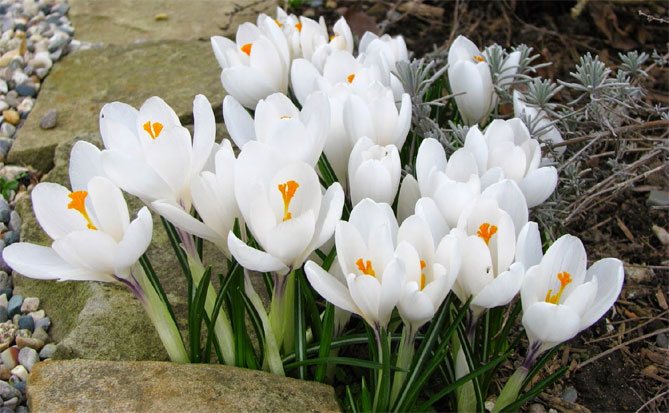

Planting difference in autumn and spring
The main difference in this procedure is the variety you took - they are divided into autumn flowering and spring flowering.The first ones are planted from the end of May to the first half of July - the climatic conditions of your region affect the accuracy. If you expect to see bloom in the spring, planting plants should be done in the fall. This option is considered the most popular among gardeners, it will be discussed in more detail.
Did you know? For the first time, European gardens were replenished with exotic crocuses at that time in the 16th century - these were Dutch hybrids.
What conditions are necessary for growing
Plants in the open field are quite unpretentious:
- moderate watering is needed to keep the soil moist. Some varieties do not tolerate waterlogging, and a drainage embankment of large pebbles is equipped for them;
- the best option is a well-lit place. A thin shadow is acceptable. There are species that grow well even under trees, but there are few such varieties;
- crocuses love moderate temperatures: it is no coincidence that the flowering period occurs in autumn or early spring, while there are no scorching rays of the sun;
- it is important to follow the rules and peculiarities of planting: fertilize the soil, maintain the interval between adjacent bulbs, do not deepen the base by more than two bulb heights (with optimal looseness of the substrate). It is necessary to water the future plants well, then make sure that the weeds do not clog the young shoots. It is imperative to fight weeds, it is useful to loosen.
Combination with other plants
A low plant with delicate goblet buds is planted:
- in the foreground next to other flowers;
- along the edges of lawns;
- on the alpine slides;
- in the center of compositions, for example, on flower beds;
- on green lawns to create a bright "carpet";
- near garden paths, for decorating narrow and wide stripes;
- perennial plants are sown next to the holes, annual species are added directly to the hole with the bulbs;
- an interesting option is planting crocuses near conifers;
- combination with other primroses in group plantings;
- on small light lawns where grass is sown.
Some landscape designers suggest planting 10-15 bulbs per hole to create vibrant color spots in the center of the composition. With this approach, lush landings are obtained.
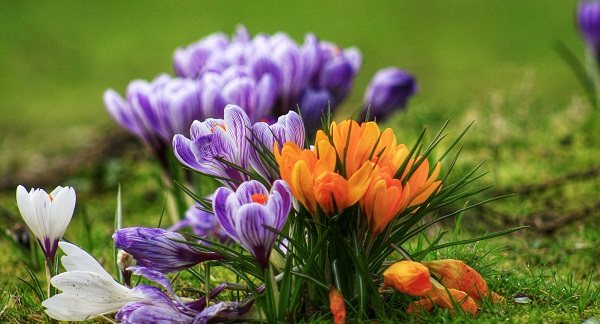

Why don't they bloom
Sometimes planted crocuses stop blooming. There are several reasons for this problem.


Incorrect fit
Flowering problems can arise from improper planting of saffron. The plant blooms more slowly if the planting is too close. Therefore, when planting, it is necessary to ensure that the bushes are at a sufficient distance from each other. Also, flowers do not bloom due to non-compliance with planting dates and improper care.
Excessive division
Sometimes the mother's bulb gives a lot of babies, which negatively affects the development of the flower. In this case, most of the nutrient components are spent on the development of daughter bulbs, and therefore flowering may be delayed or not start at all. In case of excessive dividing, it is necessary to remove all young bulbs so that they do not interfere with plant growth.
Pests
Plants can stop blooming due to the fact that they are attacked by dangerous pests. Most often crocuses suffer from rodents that feed on mature bulbs. Due to serious damage, flower buds cease to form on the bushes, and the plant gradually dies. To protect the seedlings from rodents, you will have to plant them in plastic containers.
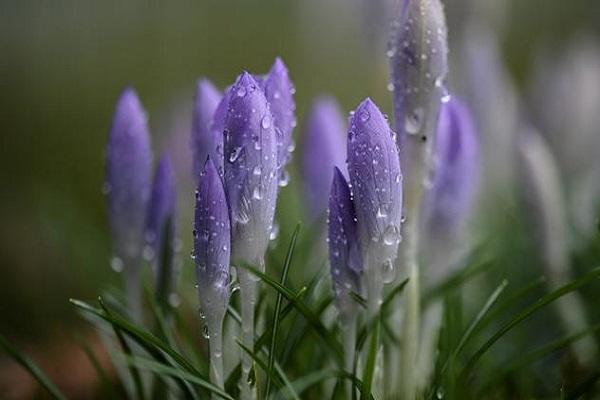

Wrong variety selected
There are spring-blooming and autumn-blooming flowers that are planted at different times. Inexperienced gardeners who have not previously planted crocuses often confuse varieties, which leads to poor flowering and slow growth of the seedlings. Therefore, to avoid confusion, it is necessary to figure out in advance which variety is planted in the garden..
Imeretian variety
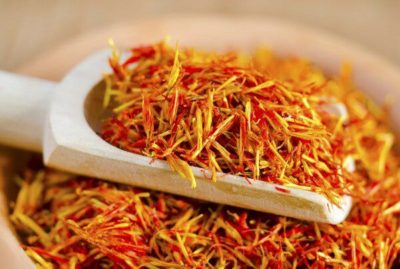

Another name is zafaran. Belongs to the Astrov family. An annual herb. According to the botanical description, Imeretian saffron is almost identical to marigolds:
- The stem is upright, up to 50 cm high.
- Leaves up to 11 cm long, finely dissected.
- Inflorescences appear in mid-summer.
You can also make a spice from Imeretian saffron. But it will differ from real saffron in taste, aroma and price (much cheaper).
Important! The beneficial properties of Imeretian saffron are significantly inferior to the present.

